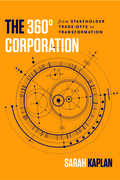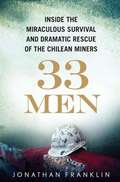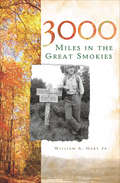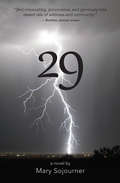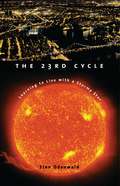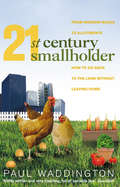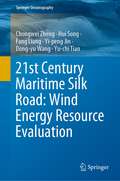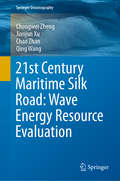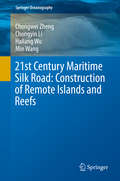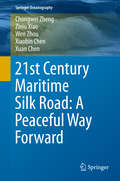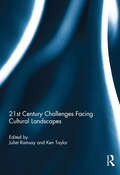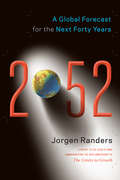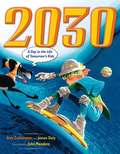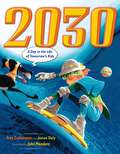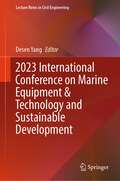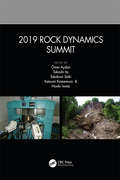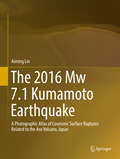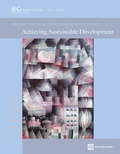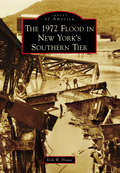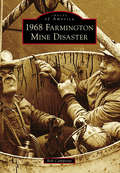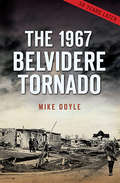- Table View
- List View
365 Ways to Live Green
by Diane Gow McdildaIt's the choices we make every day that affect our world tomorrow...365 Ways to Live Green offers an extended list of opportunities to live with more care for the environment by educating, inspiring and motivating people to look at the choices that are made everyday, and challenging them to change their habits. Broken down into 365 tips, with two concise points per page, readers can use this book to learn to make better everyday choices, from picking safer cleaning products to alternative holidays - this is everyone's all-purpose guide to green living.
365 Ways to Live Green
by Diane Gow McDildaIt's the choices we make every day that affect our world tomorrow365 Ways to Live Green offers an extended list of opportunities to live with more care for the environment by educating, inspiring and motivating people to look at the choices that are made everyday, and challenging them to change their habits. Broken down into 365 tips, with two concise points per page, readers can use this book to learn to make better everyday choices, from picking safer cleaning products to alternative holidays-this is everyone's all-purpose guide to green living.
The 360° Corporation: From Stakeholder Trade-offs to Transformation
by Sarah KaplanCompanies are increasingly facing intense pressures to address stakeholder demands from every direction: consumers want socially responsible products; employees want meaningful work; investors now screen on environmental, social, and governance criteria; "clicktivists" create social media storms over company missteps. CEOs now realize that their companies must be social as well as commercial actors, but stakeholder pressures often create trade-offs with demands to deliver financial performance to shareholders. How can companies respond while avoiding simple "greenwashing" or "pinkwashing"? This book lays out a roadmap for organizational leaders who have hit the limits of the supposed win-win of shared value to explore how companies can cope with real trade-offs, innovating around them or even thriving within them. Suggesting that the shared-value mindset may actually get in the way of progress, bestselling author Sarah Kaplan shows in The 360° Corporation how trade-offs, rather than being confusing or problematic, can actually be the source of organizational resilience and transformation.
33 Men: Inside the Miraculous Survival and Dramatic Rescue of the Chilean Miners
by Jonathan Franklin<p>Having had unparalleled access to the Chilean mine disaster, award-winning journalist Jonathan Franklin takes readers to the heart of a remarkable story of human endurance, survival, and historic heroism. <p><i>33 Men</i> is the groundbreaking, authoritative account of the Chilean mine disaster, one of the longest human entrapments in history. Rushing to the scene when the miners were discovered, Franklin obtained a coveted "Rescue Team" pass and reported directly from the front lines of the rescue operation, beyond police controls, for six weeks. Based on more than 110 intimate interviews with the miners, their families, and the rescue team, Franklin's narrative captures the remarkable story of these men and women, in details shocking, beautiful, comedic, and heroic. <p>Gripping and raw with never-before-revealed details, <i>33</i> Men is a true story that reads like a thriller.</p>
3000 Miles in the Great Smokies
by William A. Hart Jr.A hiking memoir by &“a man whose soul is held in thrall by remote places in the Smokies where . . . rising trout and fog-laden valleys rule supreme&” (Jim Casada, The Literature of Hiking in the Smokies). Bill Hart has hiked, camped and fished in the Great Smoky Mountains National Park for more than forty years. In over three thousand miles of walking, he has recorded experiences and impressions that will delight readers of all ages. Whether exploring some of the most remote sections of the Smokies, angling for trout, meeting mountain folk, or marveling at the flora and fauna around him, Bill has a gift for heartfelt storytelling and a wealth of knowledge to share about the park. Join him for an unforgettable journey through a beloved national treasure. Includes photos &“[A] collection of essays and journal entries of over 40 years of hiking, camping and exploring in the Great Smoky Mountain National Park.&” —Go Knoxville &“A compilation of thoughts and reminiscences of his wonderful days and nights there.&” —Smoky Scout&’s Hiking Adventures
3-D Seismic Interpretation
by M. Bacon R. Simm T. RedshawThis book introduces geophysicists and geologists to the technique of interpreting 3-D seismic data. The topics it covers include basic structural interpretation and map-making; the use of 3-D visualization methods; interpretation of seismic amplitudes; the generation and use of AVO and acoustic impedance datasets; and time-lapse seismic mapping. Written by professional geophysicists with many years of working experience in the oil industry, the book will be indispensable for graduate students, researchers, and new entrants into the petroleum industry.
29
by Mary Sojourner"Ever-ascending Sojourner cooks up wrenching sorrow and hilarious banter, environmental and moral conundrums, magnetizing characters, and a place of transcendent beauty in this intoxicating, provocative, and gloriously told desert tale of wildness and community, unexpected bonds and deep legacies, trauma and healing."-Donna Seaman, BOOKLIST (starred review) "This standout ecological novel from Arizona author Sojourner (Going Through Ghosts) features picturesque prose, a vivid western setting, and sharply drawn characters."-PUBLISHERS WEEKLY (starred review)"In Nell Walker, Mary Sojourner has created a character who discovers-in her own desperate way-the simple beauty in the interconnectedness of the natural world and the complexities we heap upon it. Written with passion and humor, 29 takes the reader on a journey of hope, humanity, and love."-Jana Richman, author of Riding in the Shadows of Saints, The Last Cowgirl, and The Ordinary Truth"29 is at the intersection of a local road to Nowhere and an interstate to Everywhere. Certainly Mary's prose and storytelling is crystalline and lovely, a kind of geode broth, filled with light and piquancy."-David Kranes, author of The Legend's Daughter and The National Tree"Sojourner's desert eyes not only see but transform what others dismiss and ignore. She brings readers deep into the dust and sparkle of the Mojave, forcing the reader to hear the people of the desert-their stories, their sorrows, and their fierce and fragile loves. 29 holds the ragged weeping desert open, then kisses closed her wounds. A love letter to what we frequently deem unloveable, 29 is a wide-armed triumph of hope."-Laraine Herring, author of Ghost Swamp Blues and Writing Begins with the Breath"This is a story that will stay with the readers and, perhaps, bring them home to their own place, and the importance of fighting for what you love."-Susan Lang, author of the Mojave novels trilogy"The language is sharp as a butcher's blade, the dialogue rings true and hard, and the story cuts deeply into its reader."-H. Lee Barnes, author of Cold Deck, The Lucky, and Car Tag"Sojourner's new novel, much like the desert landscapes in which it is set, will never speak to those who see the Mojave as an annoying blur between L.A. and Vegas, but those adventurous enough (or lost enough) to wander off I-15 will find a world bursting with fragile beauty, tenacious life, and rock hard truth."-Giles Carwyn, author of Queen of Oblivion
The 23rd Cycle: Learning to Live with a Stormy Star
by Sten OdenwaldOn March 13, 1989, the entire Quebec power grid collapsed, automatic garage doors in California suburbs began to open and close without apparent reason, and microchip production came to a halt in the Northeast; in space, communications satellites had to be manually repointed after flipping upside down, and pressure readings on hydrogen tank supplies on board the Space Shuttle Discovery peaked, causing NASA to consider aborting the mission. What was the cause of all these seemingly disparate events? Sten Odenwald gives convincing evidence of the mischievous—and potentially catastrophic—power of solar storms and the far-reaching effects of the coming "big one" brewing in the sun and estimated to culminate in the twenty-third cycle in the year 2001 and beyond. When the sun undergoes its cyclic "solar maximum," a time when fierce solar flares and storms erupt, fantastic auroras will be seen around the world. But the breathtaking spectacles will herald a potentially disastrous chain of events that merit greater preparation than Y2K. Is anyone listening?The 23rd Cycle traces the previously untold history of solar storms and the ways in which they were perceived by astronomers—and even occasionally covered up by satellite companies. Punctuated with an insert containing dramatic color images showing the erupting sun, the book also includes a history of the record of auroral sightings, accounts of communications blackouts from the twentieth century, a list of industries sensitive to solar storms, and information about radiation and health issues.
21st-Century Smallholder: From Window Boxes To Allotments: How To Go Back To The Land Without Leaving Home
by Paul WaddingtonAchieving genuine self-sufficiency of the kind described in John Seymour's classic guide is sadly beyond the vast reach of the urban majority today. Few have the space, and for those few there are comprehensive guidebooks. But where do the rest of us look for the answers to questions like how much effort does it really take to grow your own food? Is beekeeping difficult? Is solar power really worth the bother?From a small terraced house in the middle of a big city, Paul Waddington has made it his business to find out, and while trying it himself, has created a practical and absorbing guidebook along the way. It includes easy-to-read lists, tables, personal anecdote, and stunning illustrations, and more importantly demystifies the subject with practical tips that get to the heart of the matter to show you how you can enjoy the fulfilling aspects of the smallholding life without the hassle and expense of 'going all the way'. If you want to go back to the land without leaving home, this is the perfect guide.
21st Century Maritime Silk Road: Wind Energy Resource Evaluation (Springer Oceanography)
by Chongwei Zheng Hui Song Fang Liang Yi-peng Jin Dong-yu Wang Yu-chi TianThis book aims to establish a wind energy evaluation system, to provide scientific reference for site selection, daily operation and long-term planning of wind power generation, thus to make contribution to breaking the shackles of power shortage. Firstly, it presents the advantages and disadvantages of offshore wind power, then further discusses about the status quo and challenges for wind power programs along the Maritime Silk Road and offer suggestions. A wind energy evaluation system was proposed with the Maritime Silk Road as a case study, including climatic features of wind power (temporal-spatial distribution), long-term climatic trend and mechanism, short-term forecast of wind energy, mid- and long-term projection of wind energy, technology of wind energy evaluation on key point or vital region and offshore wind energy dataset construction, to provide systematic and scientific reference for wind power evaluation and utilization.This book is one of the series of publications on 21st century Maritime Silk Road (shortened as “Maritime Silk Road”). It covers the characteristics of the marine environment and marine renewable energy, remote islands and reefs construction, climate change, early warning of wave disasters, legal escort, marine environment and energy big data construction, etc., contributing to the safe and efficient construction of the Maritime Silk Road. It aims to improve our knowledge of the ocean, thus, to improve the capacity for marine construction, enhance the viability of remote islands and reefs, ease the energy crisis and protect the ecological environment, improve the quality of life of residents along the Maritime Silk Road, and protect the rights, interests of the countries and regions participating in the construction of the Maritime Silk Road. It is a valuable reference for decision-makers, researchers, and marine engineers working in the related fields.
21st Century Maritime Silk Road: Wave Energy Resource Evaluation (Springer Oceanography)
by Chongwei Zheng Jianjun Xu Chao Zhan Qing WangThis book focuses on the evaluation of wave energy in the Maritime Silk Road. Firstly, it compares wave energy and other main energy sources, and then discusses the various disadvantages. It also presents the current research and the difficulties of wave energy evaluation, and systematically analyzes the climatic characteristics of the wave energy, including the temporal–spatial distribution and climatic trend of a series of key factors (e.g. wave power density, availability, richness, stability, energy direction, energy storage). It then describes the design of a short-term forecasting scheme and a long-term projection scheme of wave energy suitable for the Maritime Silk Road, to serve as a plan for the daily operation and long-term development of wave energy. Further, it highlights the wave energy analysis and decision-making in the context of the remote islands and reefs, using Sri Lanka is taken as a case study. Lastly, it presents the first wave energy resource dataset for the Maritime Silk Road.This book is one of a series of publications on the 21st century Maritime Silk Road (shortened as “Maritime Silk Road”) that covers the characteristics of the marine environment and marine new energy, remote islands and reef construction, climate change, early warning of wave disasters, legal escort, marine environment and energy big data construction, contributing to the safe and efficient construction of the Maritime Silk Road. It aims to improve our knowledge of the ocean, and so improve the capacity for marine construction, enhance the viability of remote islands and reefs, ease the energy crisis and protect the ecological environment and improve the quality of life of residents along the Maritime Silk Road, as well as to protect the rights, and interests of the countries and regions participating in the construction of the Maritime Silk Road. This book is a valuable reference resource for decision-makers, researchers, and marine engineers working in the related fields.
21st Century Maritime Silk Road: Construction of Remote Islands and Reefs (Springer Oceanography)
by Chongwei Zheng Chongyin Li Hailang Wu Min WangThis book focuses on the construction of remote islands and reefs in the Maritime Silk Road. Firstly, it analyzes the functions, necessity and difficulties of the construction of remote islands and reefs; then provides corresponding countermeasures. According to the urgent demand of electricity and freshwater, it focus on wave and offshore wind energy evaluation of the important remote islands and reefs of the Maritime Silk Road, providing reference for the choice of location of power plants, daily operation and long term plan of wave/wind power generation. Several important key points are selected in the case study to realize their electricity and freshwater self-sufficiency and thus to improve their viability. This book also presents the marine characteristics (especially hazardous elements) under the demands of island runway construction and marine new energy development, to promote safe and efficient implementation of the remote islands and reefs construction. This book is one of the series of publications on the 21st Century Maritime Silk Road (shortened as “Maritime Silk Road”). It covers the characteristics of the marine environment and marine new energy, remote islands and reefs construction, climate change, early warning of wave disasters, legal escort, marine environment and energy big data construction, etc. contributing to the safe and efficient construction of the Maritime Silk Road. It aims to improve our knowledge of the ocean, thus to improve the capacity for marine construction, enhance the viability of remote islands and reefs, ease the energy crisis and protect the ecological environment, improve the quality of life of residents along the Maritime Silk Road, and protect the rights, interests of the countries and regions participating in the construction of the Maritime Silk Road. It will be a valuable reference for decision-makers, researchers, and marine engineers working in the related fields.
21st Century Maritime Silk Road: A Peaceful Way Forward (Springer Oceanography Ser.)
by Chongwei Zheng Ziniu Xiao Wen Zhou Xiaobin Chen Xuan ChenThis book focuses on understanding the characteristics of the marine environment; overall characteristic of the marine resources (especially the marine new energy) and their current utilization; important routes, channels, and ports; and the Maritime Silk Road from the perspective of international law. It also discusses the significance and opportunities of the Maritime Silk Road initiative, analyzes the challenges involved in the construction of the Maritime Silk Road and provides corresponding countermeasures. Based on the above research, this book also proposes to construct a comprehensive application platform for the Maritime Silk Road that will be a practical tool for decision-making. <P><P> This book is one of the series publications on the 21st century Maritime Silk Road (shortened as “Maritime Silk Road”). This series publications cover the characteristics of the marine environment and marine new energy, remote islands and reefs construction, climate change, early warning of wave disasters, legal escort, marine environment and energy big data construction, etc. contributing to the safe and efficient construction of the Maritime Silk Road. It aims to improve our knowledge of the ocean, thus to improve the capacity for marine construction, enhance the viability of remote islands and reefs, ease the energy crisis and protect the ecological environment, improve the quality of life of residents along the Maritime Silk Road, and protect the rights, interests of the countries and regions participating in the construction of the Maritime Silk Road. It will be a valuable reference for decision-makers, researchers, and marine engineers working in the related fields.
21st Century Challenges Facing Cultural Landscapes
by Juliet Ramsay and Ken TaylorThrough stories of diverse landscapes from around the world, this book captures human cultures and their land use practices in the environments they inhabit. The chapters cover topics from heritage in the 21st Century, appreciating and safeguarding values while facing challenges wrought by change.This title will lead readers through fascinating stories of landscapes and people. We learn of the physical and spiritual structure of rice terraces of the Honghe Mountains in China maintained by following a 1300 year sustainable practice of water allocation, while the colonial tea plantations of the Sri Lankan highlands are managed by Indian Tamils who now seek tourism as a means of additional income. Sustainable agricultural methods in the USA are being introduced to prevent landscape loss while in Australia a challenge confronting family farms is progressing to rural industrialisation. Challenges are further outlined in the mythical story of Finland's Saint Henrik pilgrimage and in the intangible Ui-won gardens of Korea. The huge challenge for Japan's landscapes is the legacy from fierce natural 21st Century disasters while in Australia's Dampier Archipelago, an avoidable yet brutal development on a unique Aboriginal rock sculptured landscape highlights serious concerns about heritage governance. These remarkable stories of landscapes and their management are inseparable from the communities that inhabit them. This book was originally published as a special issue of Landscape Research.
2052: A Global Forecast for the Next Forty Years
by Jorgen RandersForty years ago,The Limits to Growthstudy addressed the grand question of how humans would adapt to the physical limitations of planet Earth. It predicted that during the first half of the 21st century the ongoing growth in the human ecological footprint would stop-either through catastrophic "overshoot and collapse"-or through well-managed "peak and decline. "So, where are we now? And what does our future look like? In the book2052, Jorgen Randers, one of the co-authors ofLimits to Growth, issues a progress report and makes a forecast for the next forty years. To do this, he asked dozens of experts to weigh in with their best predictions on how our economies, energy supplies, natural resources, climate, food, fisheries, militaries, political divisions, cities, psyches, and more will take shape in the coming decades. He then synthesized those scenarios into a global forecast of life as we will most likely know it in the years ahead. The good news: we will see impressive advances in resource efficiency, and an increasing focus on human well-being rather than on per capita income growth. But this change might not come as we expect. Future growth in population and GDP, for instance, will be constrained in surprising ways-by rapid fertility decline as result of increased urbanization, productivity decline as a result of social unrest, and continuing poverty among the poorest 2 billion world citizens. Runaway global warming, too, is likely. So, how do we prepare for the years ahead? With heart, fact, and wisdom, Randers guides us along a realistic path into the future and discusses what readers can do to ensure a better life for themselves and their children during the increasing turmoil of the next forty years.
2030: A Day In The Life Of Tomorrow's Kids
by Amy Zuckerman James DalyGlobal events and new technology change how we live from moment to moment. So, what will our world be like in twenty years? Come take a look as futurists Amy Zuckerman and James Daly examine what a kid?s daily life might be like in the year 2030. Inspired and informed by trends and scientifi c and technological research, 2030 is not only a peek at some cool future gadgets (talking dog collars, cars that drive themselves), but also a thoughtful examination of how our lives might be impacted as we adjust to environmental change.
2030: A Day in the Life of Tomorrow's Kids
by Amy Zuckerman James DalyWinner of the 2012 Grand Canyon Reader Award for a Non-fiction bookGlobal events and new technology change how we live from moment to moment. So, what will our world be like in twenty years? Come take a look as futurists Amy Zuckerman and James Daly examine what a kid?s daily life might be like in the year 2030. Inspired and informed by trends and scientifi c and technological research, 2030 is not only a peek at some cool future gadgets (talking dog collars, cars that drive themselves), but also a thoughtful examination of how our lives might be impacted as we adjust to environmental change.
2023 International Conference on Marine Equipment & Technology and Sustainable Development (Lecture Notes in Civil Engineering #375)
by Desen YangThis book contains original, peer-reviewed, and selected research papers that were presented at the 2023 International Conference on Marine Equipment & Technology and Sustainable Development, which took place in Beijing, China on April 1st 2023. The papers cover a range of topics, including but not limited to: the vision and goals of building a maritime community with a shared future, marine machinery and transportation, marine ecology, environmental protection and conservation, marine safety, future ships and marine equipment, marine engineering, marine information and technology, maritime policy, and global governance.The papers included in this volume provide the latest findings on methodologies, algorithms, and applications in marine equipment and technology, as well as sustainable development. As a result, this book is an invaluable resource for researchers, engineers, and university students who are interested in these fields.
2019 Rock Dynamics Summit: Proceedings of the 2019 Rock Dynamics Summit (RDS 2019), May 7-11, 2019, Okinawa, Japan
by Ömer Aydan Takashi Ito Takafumi Seiki Katsumi Kamemura Naoki IwataRock dynamics has become one of the most important topics in the field of rock mechanics and rock engineering, and involves a wide variety of topics, from earthquake engineering, blasting, impacts, failure of rock engineering structures as well as the occurrence and prediction of earthquakes, induced seismicity, rock bursts to non-destructive testing and explorations. Rock dynamics has wide applications in civil and infrastructural, resources and energy, geological and environmental engineering, geothermal energy, and earthquake hazard management, and has become one of the most topical areas. 2019 Rock Dynamics Summit contains 8 keynote addresses and 128 regular full papers that were presented at the 2019 Rock Dynamics Summit (2019 RDS, Okinawa, Japan, 7-11 May 2019), a specialized conference jointly organized by the Rock Dynamics Committee of the Japanese Society of Civil Engineers (JSCE-RDC), the Japanese Society for Rock Mechanics (JSRM), and which was supported by the International Society for Rock Mechanics and Rock Engineering (ISRM) and the Turkish National Society for Rock Mechanics (TNSRM). The contributions cover a wide range of topics on the dynamic behavior of rock and rock masses and scientific and engineering applications, and include: - Laboratory tests on Dynamic Responses of Rocks and Rock Masses / Fracturing of Rocks and Associated Strong Motions- Estimation Procedures and Numerical Techniques of Strong Motions Associated with the Rupture of Earth’s Crust and Some Strong Motion- Dynamic Response and Stability of Rock Foundations, Underground Excavations in Rock, Rock Slopes Dynamic Responses and Stability of Stone Masonry Historical Structures and Monuments- Induced Seismicity- Dynamic Simulation of Loading and Excavation- Blasting and machinery induced vibrations- Rockburst, Outburst, Impacts- Nondestructive Testing Using Shock Waves- Case Histories of Failure Phenomenon in Rock Engineering 2019 Rock Dynamics Summit contains the state-of-the-art in rock dynamics, and will be invaluable to professionals and academics interested in the latest advances in new techniques for experiments, analytical and numerical modelling as well as monitoring in dynamics of rocks and rock engineering structures.
2019 International Bamboo Construction Competition: From the Concepts to the Realized Pavilions (Springer Tracts in Civil Engineering)
by Kewei Liu Cristoforo Demartino Zhi Li Qinghui Liu Yan XiaoThis volume builds upon the 2019 International Bamboo Construction Competition (IBCC 2019) from the Concepts to the Realized Pavilions. Several designed projects are described, and particular attention is devoted to the realized prototypes. It also presents the Bamboo Eye, an important example of architecture realized by INBAR for the 2019 Beijing Horticultural Expo. As such, the volume provides an overview of the use of bamboo poles and engineered bamboo products for temporary and normal constructions, and represents a compact review of the applications of bamboo poles and/or engineered bamboo products in the construction industry. This book will be of interest for researchers, architects and structural engineers in field of bamboo constructions.
The 2016 Mw 7.1 Kumamoto Earthquake
by Aiming LinThis book shows the deformation characteristics of coseismic surface ruptures produced by the 2016 Kumamoto earthquake and the relationship between the Aso volcano and active faults. In particular, the rupturing mechanisms and processes involved in the seismogenic faults related to the crustal structure under the Aso volcano caldera are covered. The book is intended to help bridge the gaps between seismology, seismic disaster prevention, volcanology, seismotectonics, and geology and to encourage further studies of earthquake mechanisms and seismic faulting processes.
2009 Annual Review of Development Effectiveness
by World Bank'The Annual Review of Development Effectiveness 2009' presents evidence on the World Bank's efforts in two areas. Part I tracks the outcomes of Bank projects and country programs and the evolution of monitoring and evaluation (M and E). Part II examines the Bank's support for environmentally sustainable development compatible with economic growth and poverty reduction. The Bank's project performance rebounded in 2008, allaying concerns about the weakened performance in 2007. As previous ARDEs have shown, project performance has been improving gradually for 15 years according to the traditional measure-percent of projects with satisfactory (versus unsatisfactory) outcomes. But IEG ratings of M and E quality for completed projects indicate considerable room for progress. Information to assess impacts continues to be lacking although preliminary data suggests improvements in baseline data collection. Bank support for the environment has recovered since 2002 due to new sources of concessional finance. The outcomes of environment projects have improved in recent years. A growing number of regional projects are addressing the shared use of water resources. New global partnerships are deepening the Bank's involvement in climate change issues. But M and E remains weak: three-quarters of environment-related projects-those managed by sectors other than environment-lack reporting of environmental outcomes.
1972 Flood in New York's Southern Tier, The (Images of America)
by Kirk W. HouseIn June 1972, Hurricane Agnes hit the East Coast with a monstrous and devastating force, bringing a deluge across multiple states and slamming four counties in the Southern Tier: Steuben, Chemung, Tioga, and Broome. Dozens died and property damage ran into the millions as Corning, Elmira, Owego, Binghamton, and other communities suddenly found themselves under water. The flood destroyed the Erie Lackawanna Railroad, staggered the Penn Central, shut down Corning Glass Works for weeks, and devastated the Corning Museum of Glass--a major cultural resource. Lives and landscapes were forever changed when homes and businesses washed away in a matter of minutes. Henceforth, the region's history became permanently divided into the times before and the times after the 1972 flood. Through stunning images, The 1972 Flood in New York's Southern Tier chronicles the extraordinary destruction of twisted rail lines, devastated streets, exhausted recovery workers, rivers bursting their banks, cars on houses, and houses on cars, all while capturing the communities' rebuilding efforts and recovery of the glass museum treasures.
1968 Farmington Mine Disaster (Images of America)
by Bob CampioneCoal in the United States was discovered in the 18th century by landowners and farmers on the slopes of the hillsides in the Appalachian region. It was not until the late 19th century that this black rock would become a part of an industrial revolution. One of the first mines to commercially produce coal was in Fairmont, West Virginia, and began the Consolidated Coal Corporation. On November 20, 1968, the Farmington No. 9 mine explosion changed the course of safety for future mining and the lives of 78 families whose sons, husbands, fathers, and loved ones never came back from the cateye shift the next day.
1967 Belvidere Tornado, The: A 40-year Anniversary Perspective (Disaster)
by Mike DoyleClaiming the lives of seven adults and seventeen children, the Belvidere tornado struck the most vulnerable at the worst possible time: just as school let out. More than five hundred people suffered injuries. New interviews and fascinating archival history underscore the horrific drama, as well as the split-second decisions of victims and survivors that saved their families and neighbors. Since the tragedy, three more devastating tornadoes have further defined Boone County’s resilience: Poplar Grove in 2008, Caledonia in 2010 and Fairdale in 2015.

